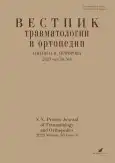Clinical tests in the diagnosis of scapholunate ligament injuries
- Authors: Golubev I.O.1, Gazimieva B.M.2,3, Sautin M.E.3, Korolev A.V.2,3
-
Affiliations:
- Priorov National Medical Research Center of Traumatology and Orthopedics
- Peoples’ Friendship University of Russia
- European Medical Center
- Issue: Vol 30, No 4 (2023)
- Pages: 385-392
- Section: Original study articles
- URL: https://journals.rcsi.science/0869-8678/article/view/254209
- DOI: https://doi.org/10.17816/vto340922
- ID: 254209
Cite item
Full Text
Abstract
BACKGROUND: Non-invasive instrumental methods of scapholunate ligament injuries, one of the main wrist joint stabilisers, are complicated by frequent false results of examination, and therefore clinical testing is essential in making the diagnosis. At the same time, the limited number of existing specific tests requires evaluation of their prognostic accuracy.
AIM: Evaluating the diagnostic significance of alternative specific tests in the diagnosis of scapholunate ligament injuries.
MATERIALS AND METHODS: In this study, we performed clinical examination and testing of both carpal joints in 50 subjects who had no complaints of carpal joint dysfunction or pain and denied a history of trauma. In clinical testing, the presence or absence of pain during palpation in the projection of the scapholunate ligament was analysed, as well as the specific Watson test, the navicular balloting test and the Kleinman test, for which specificity was assessed.
RESULTS: The specificity of scapholunate ligament palpation as a diagnostic test was 84.0%, Watson test — 96.0%, navicular balloting test — 98.0%, Kleinman test — 87.0%. The overall specificity of clinical tests was 79.0%. A combination of Watson test, navicular balloting test and Kleinman test achieved the highest specificity (86.0%).
CONCLUSIONS: Clinical testing is an important diagnostic tool in suspected scapholunate ligament injuries, however the benefit of isolated clinical tests is not absolute and therefore the best algorithm for clinical examination of the wrist joint may be the use of several specific clinical tests in combination.
Full Text
##article.viewOnOriginalSite##About the authors
Igor O. Golubev
Priorov National Medical Research Center of Traumatology and Orthopedics
Email: iog305@mail.ru
ORCID iD: 0000-0003-2568-7307
SPIN-code: 2090-0471
MD, Dr. Sci. (Med.), Professor
Russian Federation, MoscowBella M. Gazimieva
Peoples’ Friendship University of Russia; European Medical Center
Author for correspondence.
Email: bellagazimieva@gmail.com
ORCID iD: 0000-0002-0700-6355
SPIN-code: 4836-9231
Russian Federation, Moscow; Moscow
Maksim E. Sautin
European Medical Center
Email: msautin@emcmos.ru
ORCID iD: 0000-0001-9933-7102
SPIN-code: 4152-4596
MD, Cand. Sci. (Med.)
Russian Federation, MoscowAndrey V. Korolev
Peoples’ Friendship University of Russia; European Medical Center
Email: akorolev@emcmos.ru
ORCID iD: 0000-0002-8769-9963
SPIN-code: 6980-6109
MD, Dr. Sci. (Med.), Professor
Russian Federation, Moscow; MoscowReferences
- Kitay A, Wolfe SW. Scapholunate instability: current concepts in diagnosis and management. Journal of Hand Surgery. 2012;37(10):2175–2196. doi: 10.1016/j.jhsa.2012.07.035
- Kuo CE, Wolfe SW. Scapholunate instability: current concepts in diagnosis and management. Journal of Hand Surgery. 2008;33(6):998–1013. doi: 10.1016/j.jhsa.2008.04.027
- Short WH, Werner FW, Green JK, Masaoka S. Biomechanical evaluation of ligamentous stabilizers of the scaphoid and lunate. Journal of Hand Surgery. 2002;27(6):991–1002. doi: 10.1053/jhsu.2002.35878
- Lane R, Tafti D, Varacallo M. Scapholunate Advanced Collapse. Treasure Island (FL): StatPearls Publishing; 2022.
- Fritz JM, Wainner RS. Examining diagnostic tests: an evidence-based perspective perspective. Physical Therapy. 2001;81(9):1546–64. doi: 10.1093/ptj/81.9.1546. Available from: https://academic.oup.com/ptj/article-abstract/81/9/1546/2857672
- Elzinga KE, Kamnerdnakta S, Chung KC. Concepts and artistry in the treatment of scapholunate ligament injuries. Plastic and Reconstructive Surgery. 2018;142(3):322E-333E. doi: 10.1097/PRS.0000000000004690
- Ruston J, Konan S, Rubinraut E, Sorene E. Diagnostic accuracy of clinical examination and magnetic resonance imaging for common articular wrist pathology. Acta Orthopaedica Belgica. 2013;79(4):375–380. Available from: http://www.ncbi.nlm.nih.gov/pubmed/24205765
- Easterling KJ, Wolfe SW. Scaphoid shift in the uninjured wrist. J Hand Surg Am. 1994;19(4):604-6. doi: 10.1016/0363-5023(94)90265-8
- Watson KH, Ashmead D, Makhlouf VM. Examination of the scaphoid. Journal of Hand Surgery. 1988;13(5):657–660. doi: 10.1016/S0363-5023(88)80118-7
- LaStayo P, Howell J. Clinical provocative tests used in evaluating wrist pain: a descriptive study. Journal of Hand Therapy. 1995;8(1):10–17. doi: 10.1016/S0894-1130(12)80150-5
- Yao J, Skirven T, Osterman AL, Culp RW. Clinical assessment of the wrist. In: Cooney WP III, editor. The wrist: Diagnosis and operative treatment: 2nd ed. Philadelphia: Lippincott Williams & Wilkins; 2010. Р. 119–150.
- Golubev IO, Shershneva OG. Diagnosis of acute carpal instability in radial fractures. N.N. Priorov Journal of Traumatology and Orthopedics. 1998;5(4):20–23. (In Russ). doi: 10.17816/vto104826
- Wolfe SW, Kakar S. Instability. In: Wolfe SW, Hotchkiss RN, Pederson WC, et al. Green’s operative hand surgery: 8th ed. Philadelphia: Elsevier; 2021. 510 р.
- Kleinman WB. Physical examination of the wrist: Useful provocative maneuvers. Journal of Hand Surgery. 2015;40(7):1486–1500. doi: 10.1016/j.jhsa.2015.01.016
- Yerushalmy J. Statistical problems in assessing methods of medical diagnosis, with special reference to X-ray techniques. Public health reports (Washington, D.C.: 1896). 1947;62(40):1432–1449. doi: 10.2307/4586294
- Prosser R, Harvey L, LaStayo P, Hargreaves I, Scougall P, Herbert RD. Provocative wrist tests and MRI are of limited diagnostic value for suspected wrist ligament injuries: A cross-sectional study. Journal of Physiotherapy. 2011;57(4):247–253. doi: 10.1016/S1836-9553(11)70055-8
- Geissler WB, Freeland AE, Savoie FH, McIntyre LW, Whipple TL. Intracarpal soft-tissue lesions associated with an intra-articular fracture of the distal end of the radius. J Bone Joint Surg Am. 1996;78(3):357–65. doi: 10.2106/00004623-199603000-00006
- Schmauss D, Pöhlmann S, Weinzierl A, Schmauss V, Moog P, Germann G, Bickert B, Megerle K. Relevance of the Scaphoid Shift Test for the Investigation of Scapholunate Ligament Injuries. Journal of Clinical Medicine. 2022;11(21):6322. doi: 10.3390/jcm11216322
- Krastman P, Mathijssen NMC, Bierma-Zeinstra SMA, Kraan GA, Runhaar J. Diagnostic accuracy of history taking, physical examination and imaging for non-chronic finger, hand and wrist ligament and tendon injuries: A systematic review update. BMJ Open. 2020;10(11). doi: 10.1136/bmjopen-2020-037810
Supplementary files













